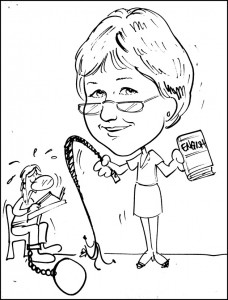Whipping Your Business Communications into Shape, with The Grammar Examiner
Truisms got their name for good reason. Communication is, indeed, the key to good relationships. That includes the relationship between a private investigator and his or her clients. The client craves results, impatiently awaits information updates from you. Hence, either you provide ongoing updates, or expect a flood of calls that interrupt your efforts and hamper investigations.
What to do? Communicate. End every day communicating with clients on the day’s successes or failures. Each client has already proved the urge to gain information, good or bad, and willingly pays dearly for the knowledge.
What not to do? Do not wait until the end of an investigation to let your clients know what information your efforts have gleaned. Certainly, that’s when you will deliver a formal, detailed final report. But in the interim, it’s wise to stay in touch and let them know of your progress along the way.
How to communicate? Phone calls offer a reassuring personal touch, but aside from logging the call, you have no record of the communication. That’s why it’s a good idea to supplement those calls with periodic emails.
Consider the following when emailing clients:
[list type=”check”]
- Tone
- Style
- Organization
- Content
- Archiving
[/list]
TONE
Tone deals with a speaker or writer’s attitude toward a subject, his audience, or himself. It may be overt, subtle, or even inadvertent. Every element of language contributes to tone, including word choice and sentence construction.
Elvis Cole’s sarcasm and insults may amuse, but only in fiction. In the real world, he would likely alienate his clients and ultimately lose them. His devoted readership may find his gruffness endearing, his crusty aloofness merely a protection of his pure soft heart. Ditto Joe Pike’s muteness, whose typical comment tends toward an uncommunicative, “Yeah.”
Real PIs must use their words, log billable hours, and deal with complexities of personalities and sometimes testy clients. They must report honestly and respectfully. To accomplish this feat is also to win the trust of their clientele. The tone of communications goes a long way toward that accomplishment.
First, employ a courteous, businesslike tone, sans slang, industry jargon, or cuteness. Why use the word “individual” or “subject” instead of “person,” or even, simply, the person’s name? You are not producing a police report but a communication between two people who will both benefit from clear, unadorned prose.
[quote align=”center” color=”#999999″]The P in PI stands for “private,” not “pedantic.”[/quote]
AVOID, however, a stilted, overly formal tone. My best advice is to write rather like you would talk, cleaned up and organized. Many writers unfortunately choose to use the passive voice, which dominates the language of government officials, pedants, and liars, as in “Mistakes were made.” (The preferred: “I made a mistake,” or better yet, “I did X, and for that I apologize.”) It also tends to plump up verbiage to annoying proportions and makes for the awkwardness and formality of one attempting a professorial tone. The P in PI, stands for “private,” not “pedantic.”
Choose two-bit instead of four-bit words. You need not plumb the limits of your vocabulary to construct an email. Just say it. Your purpose is not to impress but to express.
Avoid also the formalized reference to yourself or the recipient of the email in the third person. The following is almost laughable: This investigator encountered the client’s spouse in a compromising position with a male individual. The preferred: I photographed Mrs. X sitting in a man’s lap at the Kit Kat Club on North Main.*
[quote align=”center” color=”#999999″]*note: Avoid sending sensitive information in emails, as they are NOT, in fact, secure.
[/quote]
Avoid, too, a breezy tone that tends to trivialize your client’s case. He or she is in deadly earnest in seeking your services to solve a problem. Treat those concerns seriously by adopting a serious tone in your communications. Your goal is not to sound dour or humorless, but serious and courteous.
In short, your tone should be friendly yet businesslike, encouraging and respectful but confident and knowledgeable. You are your clients’ advocate. Your tone can help to communicate that, and to inspire confidence in you.
STYLE
Writing style is how you communicate with your audience, the way you write, including all the language tools at your disposal. Tone is actually a component of style, which also encompasses such elements of language as diction (word choice), vocabulary, syntax (sentence construction), and figurative language.
In the litany of style, technical writing is the simplest because its primary purpose is to impart often difficult information as simply and clearly as possible. The business style, however, runs a close second in simplicity. The style that you use in your emails to clients falls into the latter category. Simplicity and clarity serve as the hallmarks of the business style.
As already mentioned, your word choice should be clear, simple, and specific. The reminder that I always gave students: Specific nouns; vivid verbs.
[quote align=”center” color=”#999999″]”Specific nouns; vivid verbs.” —The Grammar Examiner[/quote]

E.B. White (of Charlotte’s Web fame) also co-wrote the quintessential guide to good writing, The Elements of Style, a slim little manual that packs a big informational whallop. In it, White charges his readers to “write with nouns and verbs.” That may sound a tad obvious, but he meant that good writing features strong nouns and verbs without reliance on adjectives and adverbs for clarity.
Try to keep sentences fairly simple as well. If a sentence seems to be taking over the entire screen, break it down into smaller constructions.
You can overdo this if all sentences tend to be unvaried and equally short. Those short bursts of verbiage can begin to sound immature and make you seem—well—simple-minded, but sentence variety, in length, type, and beginning, can prevent the impression of oversimplicity. (For example, you might occasionally begin a sentence with a prepositional phrase instead of the subject.)
[quote align=”center” color=”#999999″]ALWAYS proofread your emails before sending them.[/quote]
Most important, correct or standard grammar and syntax should dominate your writing style. Like it or not, you are judged by your grammar and usage. (And surely it needn’t be said that you should never use texting norms (u, r, 2, lol) or emoticons in a business email.) Spell, style, and grammar check can help, but nothing can replace a good proofreader. ALWAYS proofread your emails before sending them.
Just a minor point as a “by the way”: I always cautioned students not to use compound sentences joined by “and.” The result will be loosely-connected ideas.
ORGANIZATION
Organize in SHORT paragraphs. I have a friend who kindly sends me long, newsy emails—each in one loooong paragraph. As I read along, the subject changes often, but the paragraph remains the same. It’s a bit disconcerting.
More important, however, is the fact that people tend to absorb information in small bites represented by shorter paragraphs. Your reader will be intimidated by paragraphs that seem to go on interminably. If you have a long paragraph about one topic, can you break it down into smaller paragraphs? Create bullet points? If you think you can’t, do it anyway. The result will make for easier reading and be gentler on the eye.
Paragraph breaks serve as messages to your reader of changes in subject and breaks in thought. Think of other habits that you can use to help the reader follow your emails more easily. Did you notice some paragraphs above with words in bold so that the reader will know immediately the subject of the paragraph? Lists help as well, as do bullet points, but those imply ideas that are equal in importance.
All information in your emails will not be equally important, so the key to successful business writing is this: state the purpose of the email first. Place the most important points first with more detail following. Readers absorb the first points more readily, then begin to lose interest. Attention span and all that.
So you will usually organize your emails as follows:
[list type=”check”]
- State the primary message that you wish to convey.
- Explain where needed.
- Conclude with a brief encouraging word.
[/list]
CONTENT
If brevity is the soul of wit, verbosity is downright annoying. It plays fast and loose with other people’s time, needlessly. Admit it: When you receive a communique, don’t you read the first few lines and then begin scanning when it goes on and on? Most of us do.
So. . .
Once you have stated the primary message of the email, go back and read critically. Cut any words, phrases, or sentences that are not necessary to your message. Be brutal.
Keep explanations, if any, brief. Just the facts, ma’am. Keep in mind what your client needs to know NOW and what you can save until the final report.
Often your message may be that you are continuing an ongoing surveilance, have found little of note, but will continue your efforts. Your client will be heartened by the fact that you are vigilant in your work on his or her behalf. It is always a good idea to include some specifics, like the hours spent on surveillance (and how much of the retainer you’ve burned through so far).
End every email on a courteous, encouraging note.
ARCHIVING
You know well that your records are critical to your success as an investigator and the economic health of your firm. Emails can serve as an important component of those records.
To that end, save all sent and received emails to your clients’ e-files. Taken as a whole, the emails serve as an easy track of the direction the investigation is taking you. In addition, they generally detail your efforts on your clients’ behalf. They can also serve as an ongoing record of what you did and did NOT promise your client, in case the relationship goes south and accusations fly.
Additional notes on email etiquette and best practices:
[list type=”check”]
- When replying to email threads that CC multiple addressees, consider when it’s appropriate to “reply to sender” or to “reply all.” Many mistakes have been made (ahem—see “passive voice”) via this simple click error.
- Remember to BCC rather than CC when you don’t want all recipients’ addresses visible to each other.
- In your email greeting, opt for the more formal “Dear Mr./Mrs. X,” unless you’re on a first-name basis with the client.
- To avoid unfortunate send errors, don’t put the client’s address in the “To” line until your email is proof-read and ready to go.
- Most of all, as a PI, you should always consider VERY carefully whether certain information is too sensitive to send in an email.
[/list]
SUMMARY
Rules of Email Engagement:
[list type=”check”]
- Keep it brief and simple.
- Be correct in grammar, spelling, and style.
- The specific is terrific.
- Be businesslike and courteous.
- Save and send.
[/list]
 About the Author:
About the Author:
The Grammar Examiner taught high-school English for 40 years and was recognized by her citywide public school system as an outstanding ACT-prep instructor.
A tough-love drill sergeant in the classroom, she was affectionately known as “The Dragon Lady” by her students, who dared not call her by this name in person.






